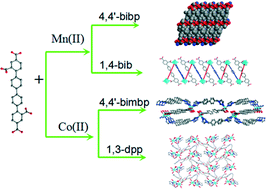Syntheses, structures and magnetic properties of four manganese(ii) and cobalt(ii) complexes†
Abstract
Hydrothermal reactions of Mn(II)/Co(II) salts and H4qptc in the presence of corresponding auxiliary N-donor ligands produced four novel complexes, {[Mn2(qptc)(4,4′-bibp)(H2O)4]·2H2O}n (1), [Mn2(qptc)(1,4-bib)(H2O)8]n (2), [Co2(qptc)(4,4′-bimbp)(H2O)2]n (3) and {[Co2(qptc)(1,3-dpp)(H2O)3]·H2O}n (4) (H4qptc = 1,1′:4′,1′′:4′′,1′′′-quaterphenyl-2,4,2′′′,4′′′-tetracarboxylic acid, 4,4′-bibp = 4,4′-bis(imidazolyl)biphenyl, 1,4-bib = 1,4-bis(1-imidazoly)benzene, 4,4′-bimbp = 4,4′-bis(imidazol-1-ylmethyl)biphenyl, 1,3-dpp = 1,3-di(4-pyridyl)propane). Single-crystal X-ray diffraction analysis showed that these complexes have different structures, including a 1D chain (2), a 2D layered structure (3), and a 3D network (1 and 4), depending on reaction conditions. Complex 1 is a 4,6-connected porous 3D framework with the point symbol (44·62)(44·610·8), which is composed of infinite 2D networks pillared by a 4,4′-bibp bridging ligand. 2 is a 1D zigzag chain, and the adjacent chains extend to a 3D supramolecular structure via non-covalent interactions involving contributions from carboxyl–water clusters. 3 is a 2D layer framework with an unprecedented topology, which are packed into a 3D supramolecular architecture by π⋯π and C–H⋯π interactions. 4 is a 4,6-connected 3D network with a Schläfli symbol of (3·4·54)(32·4·55·66·7). Furthermore, the magnetic susceptibility of complexes 1–4 have been investigated. 1 and 4 display weak antiferromagnetic behavior, 2 shows weak ferromagnetic interactions, and 3 exhibits different magnetic properties depending on temperature.


 Please wait while we load your content...
Please wait while we load your content...